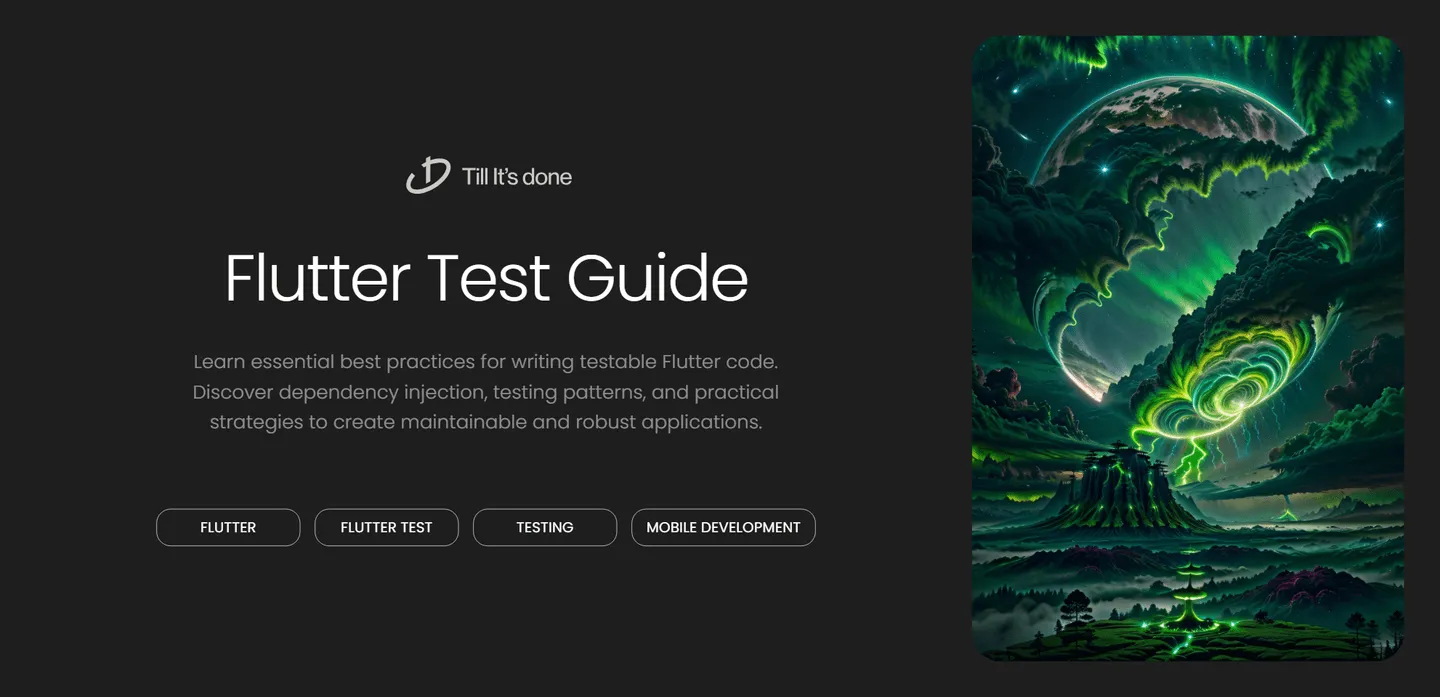- Services
- Case Studies
- Technologies
- NextJs development
- Flutter development
- NodeJs development
- ReactJs development
- About
- Contact
- Tools
- Blogs
- FAQ
Flutter Test: Write Better Testable Code Now
Discover dependency injection, testing patterns, and practical strategies to create maintainable and robust applications.

Flutter Test: Best Practices for Writing Testable Code

Writing testable code in Flutter is crucial for maintaining a robust and reliable application. As your Flutter project grows, having a solid testing strategy becomes increasingly important. In this guide, we’ll explore best practices for writing testable Flutter code that will help you build more maintainable applications.
Understanding the Importance of Testing in Flutter
Testing isn’t just about finding bugs – it’s about building confidence in your code. Flutter provides excellent testing utilities that make it easier to write and maintain tests. The key is to structure your code in a way that makes testing natural and straightforward.

Key Principles for Writing Testable Flutter Code
1. Dependency Injection
One of the most important principles for testable code is dependency injection. Instead of creating dependencies inside your widgets or classes, pass them as parameters. This makes it easier to substitute real implementations with mock objects during testing.
// Bad Practiceclass UserProfile { final _api = ApiService();}
// Good Practiceclass UserProfile { final ApiService api; UserProfile(this.api);}2. Single Responsibility Principle
Keep your widgets and classes focused on a single responsibility. This makes them easier to test and maintain. Break down complex widgets into smaller, more manageable components.
3. State Management Separation
Separate your business logic from your UI code. Using state management solutions like Provider, Riverpod, or BLoC makes your code more testable by creating clear boundaries between different layers of your application.

Best Practices for Flutter Tests
1. Write Different Types of Tests
- Unit Tests: Test individual units of code in isolation
- Widget Tests: Test widget behavior and rendering
- Integration Tests: Test how different parts work together
2. Use Test Doubles Effectively
// Example of using a mockclass MockApiService extends Mock implements ApiService { @override Future<UserData> getUserData() async { return UserData(name: 'Test User'); }}3. Golden Tests for UI Consistency
Golden tests are perfect for catching unintended visual changes in your UI. They create snapshots of your widgets and compare them against future changes.
4. Test Coverage Strategy
- Focus on testing business-critical features first
- Aim for high coverage in your business logic
- Don’t obsess over 100% coverage – focus on meaningful tests
Common Testing Patterns
1. Builder Pattern for Test Data
class UserBuilder { String name = 'Default Name'; String email = 'default@email.com';
UserBuilder withName(String name) { this.name = name; return this; }
User build() { return User(name: name, email: email); }}2. Robot Pattern for Integration Tests
The robot pattern helps create more maintainable integration tests by encapsulating common test actions and verifications.
3. Repository Pattern
Implement repositories to abstract data sources, making it easier to swap implementations during testing.
Conclusion
Writing testable Flutter code is an investment in your application’s future. By following these best practices, you can create more reliable, maintainable, and robust applications that are easier to test and debug.

Remember, the goal isn’t just to write tests, but to write code that’s naturally testable. This approach leads to better architecture and more maintainable applications in the long run.
 สร้างเว็บไซต์ 1 เว็บ ต้องใช้งบเท่าไหร่? เจาะลึกทุกองค์ประกอบ website development cost อยากสร้างเว็บไซต์แต่ไม่มั่นใจในเรื่องของงบประมาณ อ่านสรุปเจาะลึกตั้งแต่ดีไซน์, ฟังก์ชัน และการดูแล พร้อมตัวอย่างงบจริงจาก Till it’s done ที่แผนชัด งบไม่บานปลายแน่นอน
สร้างเว็บไซต์ 1 เว็บ ต้องใช้งบเท่าไหร่? เจาะลึกทุกองค์ประกอบ website development cost อยากสร้างเว็บไซต์แต่ไม่มั่นใจในเรื่องของงบประมาณ อ่านสรุปเจาะลึกตั้งแต่ดีไซน์, ฟังก์ชัน และการดูแล พร้อมตัวอย่างงบจริงจาก Till it’s done ที่แผนชัด งบไม่บานปลายแน่นอน  Next.js สอน 14 ขั้นตอนเบื้องต้น: สร้างโปรเจกต์แรกใน 30 นาที เริ่มต้นกับ Next.js ใน 14 ขั้นตอนเพียงแค่ 30 นาที พร้อม SSR/SSG และ API Routes ด้วยตัวอย่างโค้ดง่าย ๆ อ่านต่อเพื่อสร้างโปรเจ็กต์แรกได้ทันทีที่นี่
Next.js สอน 14 ขั้นตอนเบื้องต้น: สร้างโปรเจกต์แรกใน 30 นาที เริ่มต้นกับ Next.js ใน 14 ขั้นตอนเพียงแค่ 30 นาที พร้อม SSR/SSG และ API Routes ด้วยตัวอย่างโค้ดง่าย ๆ อ่านต่อเพื่อสร้างโปรเจ็กต์แรกได้ทันทีที่นี่  วิธีสมัคร Apple Developer Account เพื่อนำแอปขึ้น App Store ทีละขั้นตอน อยากปล่อยแอปบน App Store ระดับโลก มาอ่านคู่มือสมัคร Apple Developer Account พร้อมเคล็ดลับ TestFlight และวิธีอัปโหลดที่ง่ายในบทความเดียวนี้ได้เลย
วิธีสมัคร Apple Developer Account เพื่อนำแอปขึ้น App Store ทีละขั้นตอน อยากปล่อยแอปบน App Store ระดับโลก มาอ่านคู่มือสมัคร Apple Developer Account พร้อมเคล็ดลับ TestFlight และวิธีอัปโหลดที่ง่ายในบทความเดียวนี้ได้เลย  TypeScript Interface คืออะไร? อธิบายพร้อมวิธีใช้และข้อแตกต่างจาก Type เรียนรู้วิธีใช้ TypeScript Interface เพื่อสร้างโครงสร้างข้อมูลที่ปลอดภัยและเข้าใจง่าย พร้อมเปรียบเทียบข้อดีข้อแตกต่างกับ Type ที่คุณต้องรู้ ถูกรวมเอาไว้ในบทความนี้แล้ว
TypeScript Interface คืออะไร? อธิบายพร้อมวิธีใช้และข้อแตกต่างจาก Type เรียนรู้วิธีใช้ TypeScript Interface เพื่อสร้างโครงสร้างข้อมูลที่ปลอดภัยและเข้าใจง่าย พร้อมเปรียบเทียบข้อดีข้อแตกต่างกับ Type ที่คุณต้องรู้ ถูกรวมเอาไว้ในบทความนี้แล้ว  Material-UI (MUI) คืออะไร อยากสร้าง UI สวยงามและเป็นมืออาชีพในเวลาอันรวดเร็วใช่ไหม มาทำความรู้จักกับ Material-UI (MUI) ที่ช่วยให้คุณพัฒนาแอปพลิเคชันบน React ได้ง่ายและดูดีในทุกอุปกรณ์
Material-UI (MUI) คืออะไร อยากสร้าง UI สวยงามและเป็นมืออาชีพในเวลาอันรวดเร็วใช่ไหม มาทำความรู้จักกับ Material-UI (MUI) ที่ช่วยให้คุณพัฒนาแอปพลิเคชันบน React ได้ง่ายและดูดีในทุกอุปกรณ์  เปรียบเทียบ 3 วิธีติดตั้ง install node js บน Ubuntu: NVM vs NodeSource vs Official Repo แบบไหนดีที่สุด? เรียนรู้วิธีติดตั้ง Node.js บน Ubuntu ด้วย NVM, NodeSource หรือ Official Repo เลือกวิธีที่เหมาะกับความต้องการของคุณ พร้อมเปรียบเทียบ เพื่อการพัฒนาที่มีประสิทธิภาพ!
เปรียบเทียบ 3 วิธีติดตั้ง install node js บน Ubuntu: NVM vs NodeSource vs Official Repo แบบไหนดีที่สุด? เรียนรู้วิธีติดตั้ง Node.js บน Ubuntu ด้วย NVM, NodeSource หรือ Official Repo เลือกวิธีที่เหมาะกับความต้องการของคุณ พร้อมเปรียบเทียบ เพื่อการพัฒนาที่มีประสิทธิภาพ! พูดคุยกับซีอีโอ
We'll be right here with you every step of the way.
We'll be here, prepared to commence this promising collaboration.
Whether you're curious about features, warranties, or shopping policies, we provide comprehensive answers to assist you.


